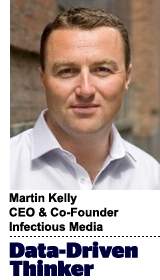 “Data-Driven Thinking” is written by members of the media community and contains fresh ideas on the digital revolution in media.
“Data-Driven Thinking” is written by members of the media community and contains fresh ideas on the digital revolution in media.
Today’s column is written by Martin Kelly, CEO and co-founder at Infectious Media.
A major shift is taking place in our industry, illustrated by Facebook shutting down its Partner Categories offering, which allowed advertisers to target third-party data audiences, or by WFA research showing that brands are demanding greater data transparency.
High-profile advertisers are rightly raising concerns about how third-party data has been sourced and its reliability, and they are also seeking to maximize the value of their own first-party data as a result.
The traditional offer of the large agency groups, built on buying scale, is no longer key to advertisers in an auction-driven programmatic environment.
Instead, data is king. Major businesses have huge amounts of first-party data, but they are increasingly frustrated that their agency partners aren’t properly geared toward helping them realize the huge potential to make use of this via programmatic.
Along with a need for greater transparency, this is driving the in-housing trend, with brands believing that the only way they can properly exploit the value of their data is to bring programmatic in-house.
A brand-new approach
Agencies need a new approach to properly meet brands’ needs. Many brands still very much see a role for agencies, despite also seeking to bring aspects of programmatic in-house.
Agencies seeking to thrive in this increasingly hybrid environment will need to be flexible – and they’ll also need to add genuine value in areas that they traditionally haven’t.
First-party data will prove a significant part of this, which means agencies will need to up their game on the tech front and bring development skills in-house that they have never felt comfortable with in the past. Developing on APIs will become table-stakes in the future as this facilitates the flow of data between systems.
And to truly deliver an offering beyond that which brands can replicate in-house, they’ll also need to act as systems integrators to ensure that an advertiser’s tech stack works together seamlessly to avoid the all-too-common “Frankenstack” of redundant technologies.
And they’ll need to think beyond planning and buying teams to building analytics, engineering and data science teams.
Making this new approach work in a hybrid environment will require agencies of the future to take a more flexible approach with their clients, adapting their services, technology and trading models to make them more modular as brands bring their own skills, data and technology to the table.
But advertisers will need to change as well. Paying agencies on commission should become a thing of the past, since programmatic is more labor-intensive than the old ways of planning and executing campaigns. I believe we will see the emergence of more FTE-based remuneration models as agencies bulk up higher-value teams in optimization, analytics and data science.
With data at the heart of the advertiser-agency relationship, it’s time to redraw every element of the operating model. This isn’t the end of the agency but the start of something new.
In a rapidly changing data-driven environment, agencies can thrive – but they need a significantly different approach, and it’s a race to get there with consultancies and enterprise-tech businesses circling overhead.
Follow Infectious Media (@Infectiousmedia) and AdExchanger (@adexchanger) on Twitter.
This post was syndicated from Ad Exchanger.

More Stories
Marketing Morsels: Hidden Valley Ranch, La-Z-Boy, Topps & More
Flashback: Jane Pauley and Deborah Norville Revisit Today’s 1989 Succession Drama
Ally Financial Revives ‘Banksgiving’ With A TikTok Twist